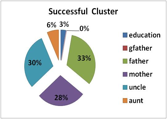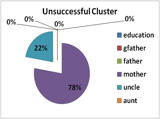Chao Yang, Setsuya Kurahashi, Keiko Kurahashi, Isao Ono and Takao Terano (2009)
Agent-Based Simulation on Women's Role in a Family Line on Civil Service Examination in Chinese History
Journal of Artificial Societies and Social Simulation
vol. 12, no. 2 5
<https://www.jasss.org/12/2/5.html>
For information about citing this article, click here
Received: 06-Oct-2008 Accepted: 30-Jan-2009 Published: 31-Mar-2009
 Abstract
Abstract

|
| Figure 1. Description of wife-taker and wife-giver |

|
| Figure 2. Adjacency matrix (Part) |

|
| Figure 3. Attribution matrix (Part) |

|
(1) |
 |
(2) |
each mi acts as a discount rate (the transmission from the great-grand father to child, for instance). And the value of i goes from 1 to 6, including the different family members such as great-grandfather, grandfather, father, mother, uncle and aunt. The variables are explained in Table 1.
| Table 1: Varibles and their descriptions used in the cultural capital transmission function | |
| Variable | Description |
| cl ck | knowledge cultural capital of the child |
| clca | artistic cultural capital of the child |
| psck | the inborn characteristic of knowledge cultural capital of the child |
| psca | the inborn characteristic of artistic cultural capital of the child |
| clik | knowledge cultural capital of member i |
| clia | artistic cultural capital of member i |
| ra | influence rate from artistic cultural capitals to knowledge cultural capitals |
| rk | influence rate from knowledge cultural capitals to artistic cultural capitals |
| m0 | cultural transmission rate from school education |
| mi | cultural transmission rate from family member i |

|
| Figure 4. Pseudo code of interaction and action between agents |

|
| Figure 5. The common parameters in cultural transmission process |

|
| Figure 6. Inverse simulation model |
 |
| Figure 7. Pseudo code of inverse simulation model |

|
| Figure 8. Parallel real-coded GA (UNDX+MGG) |
|
|
(3) |

|
| Figure 9. The network of 600 individuals in the Y family |
| Table 2: The result of the experiments | |
| Parameter | The result of Multi-Agent Based Simulation |
| People who transmit cultural capital to child | father, uncle, mother, aunt |
| Education effect | 3% |
| Effect by mother | 28%, if maternal grandfather is a successful candidate. |
| Effect by aunt | 6%, if father in aunt's married family is a successful candidate. |
| Influence rate from artistic cultural capital to knowledge cultural capital | 100% |
| Influence rate from knowledge cultural capital to artistic cultural capital | 0% |
| Transmission method of cultural capital | Both knowledge cultural capital and artistic cultural capital are transmitted to the child from parents. |

|
| Figure 10. The reciprocal relationship between wife-taker and wife-giver |

|

|
| Figure 11a | Figure 11b |
| Figure 11. Family influence in a successful cluster (left) or unsuccessful cluster (right) | |
 |
(4) |
BOURDIEU P (1979) Distinction: A Social Critique of the Judgment of Taste. Harvard University Press.
CARRINGTON P J, Scott J, and Wasserman S (2005) Models and Methods in Social Network Analysis. Cambridge University Press.
ELMAN B A (2000) A Cultural History of Civil Examinations in Late Imperial China, Berkeley: University of California Press.
GIROUX H (2001) Theory and Resistance in Education, Bergin and Garvey, 2001.
HENDRY J (1999) An introduction to social anthropology: other people's worlds, Macmillan Press Ltd, 1999.
IAN F and Carl K (2004) The Grid 2: Blueprint for a New Computing Infrastructure. Morgan Kaufmann.
IMADE H, Morishita R, Ono I and Ono N (2004) A grid-oriented genetic algorithm framework for bioinformatics. New Generation Computing, 22(2), pp.177-186.
KO D (1994) Teachers of the Inner Chambers, Women and Culture in Seventeenth-Century China. Stanford: Stanford University Press.
KURAHASHI S and Terano T (2007) Historical simulation: A study of civil service examinations, family line, and cultural capital in china. Proceedings of the 4th Conference of the European Social Simulation Association (ESSA'07), September 2007. pp. 139-150.
MANN S (1991) Grooming a daughter for marriage: Brides and wives in the mid-ching period, In Watson R S and Ebrey P B (Eds.), Marriage and Inequality in Chinese Society, pp. 204-230. University of California Press.
MANN S (1997) Precious Records, Women in China's Long Eighteenth Century. Stanford: Stanford University Press.
NYE F Ivan (Eds.) (1982) Family Relationships: Rewards and Costs. Sage Publication.
ONO I and Kobayashi S (1997) A Real-coded Genetic Algorithm for Function Optimization Using Unimodal Normal Distribution Crossover, Proc. of 7th Int. Conf. on Genetic Algorithms, pp.246-253
ONO I (2008) Grid-oriented genetic algorithms for large-scale optimization. Journal of the Society of Instrument and Control Engineers, 47(6), pp.473-479.
ONO I, Terano T and Okamoto M (2008) A proposal of grid-oriented genetic algorithm framework 2 (in Japanese), Proceedings of the 35th SICE Symposium on Intelligent Systems (SICE'08), March 2008. pp.154-159.
SATO H, Ono I and Kobayashi S (1997) A New Generation Alternation Model of Genetic Algorithms and Its Assessment. Journal of the Japanese Society for Artificial Intelligence, 12(5), pp.734-735.
TERANO T and Kurahashi S (1999) Inverse Simulation: Genetic-Algorithm Based Approach to Analyzing Emergent Phenomena. Proceedings of the International Workshop on Emergent Synthesis (IWES'99), 1999. pp. 271-276.
TERANO T (2007) Exploring the Vast Parameter Space of Multi-Agent Based Simulation. In Antunes L and Takadama K (Eds.). Proceedings of the Seventh International Workshop on Multi-Agent-Based Simulation (MABS'06), LNAI 4442, Springer, 2007. pp. 1-14.
UENO H (2000) Relative of Han People in Taiwan (in Japanese). Fukyo-sha.
WASSERMAN S and Faust K (1994) Social Network Analysis, Methods and Applications. Cambridge University Press.
WILLIS P (1977) Learning to Labour: How Working Class Kids Get Working Class Jobs. Achgate Publishing Ltd.
Return to Contents of this issue
© Copyright Journal of Artificial Societies and Social Simulation, (2009)